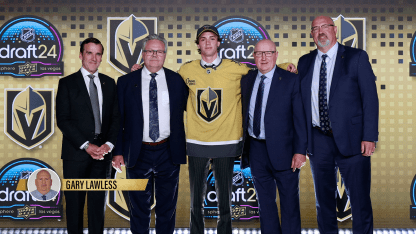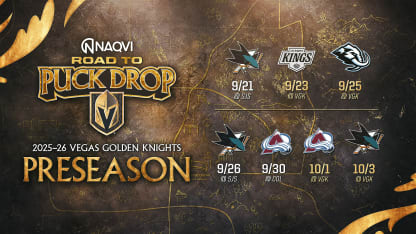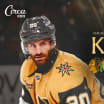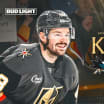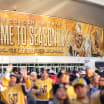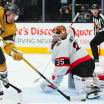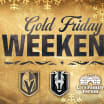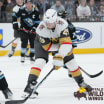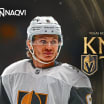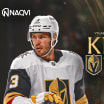The Vegas Golden Knights have their own script, and it has resulted in a Stanley Cup, two berths in the final and four trips to the conference championship round. It’s futile to argue with their success and as such with their methods. Put simply, Vegas knows what it’s doing.
Bob Lowes, Assistant Director of Player Personnel, has led Vegas at the draft table since the team’s inception. Lowes has a longtime relationship with VGK GM Kelly McCrimmon and the two see hockey through a very similar lens.
Lowes knows what McCrimmon likes in a player and he and his staff have a clear mandate to deliver value with every selection the team makes.
Lowes has found talent outside of the first round and delivered everyday NHL players such as Pavel Dorofeyev, Nicolas Hague and Kaedan Korczak.
The Golden Knights have aggressively used draft capital to add players to the roster in an attempt to extend the team’s window of Stanley Cup contention.
Trades for players like Mark Stone, Ivan Barbashev, Jack Eichel and Tomas Hertl have all been made possible by the work of Lowes and his group.
This year’s draft will see the NHL go in a different direction as teams will not be on the draft floor. Instead, hockey operations staffs and amateur scouts will be decentralized and assemble in locations of their choice. The selections will be announced from the Peacock Theater in Los Angeles.
Lowes has spent the past 12 months traversing the globe to watch players and most recently attended the NHL Scouting Combine in Buffalo.
Gary Lawless: What does the draft look like to you?
Bob Lowes: It's got good players in it. It always does at the top. I think there's some really good players. There always are. Every year has a different kind of feel to it. This year, there are some areas that normally produce players that aren't very deep.
Gary Lawless: When you don't have a first-round pick, and that can always change, so I'm probably answering my question, but do you prepare any differently or do you put your list together as if you had a pick high, low, wherever?
Bob Lowes: Yeah, we just put it together the same way that we normally do. Last year, we had a first-round pick. So, you focus in that area. Once you get it all together, you maybe do a little bit more work around that pick. But when you're putting your list together, you use the same process every year.
Gary Lawless: That enables you to be nimble if the general manager decides at the last minute or gets a call and things change. Then all of a sudden, you do have a first-round pick, you'd be very comfortable and confident in what you had to do?
Bob Lowes: Yeah, you have to be prepared for anything because you never know when you're going to get a pick or add a first-round pick. Things change just the way trades are made now at the draft and before the draft. There are always picks being moved around. There are teams that have multiple picks before us that are not going to pick everybody, right? They're going to try to get some players or try to rework their team in different ways. So, you just never know what's going to happen.
Gary Lawless: Is that fun for a staff to be all gathered together? This year, it'll be in Las Vegas instead of at the actual draft. Is that fun for you guys when the general manager walks in and says, “So and so just called us, they've got this, they've offered us this,” and then you guys all go to work and put in your opinion. Is that enjoyable?
Bob Lowes: Yeah, it’s exciting. It's what we do. So, you hope you get the opportunity. If it doesn't happen, it doesn't happen. There's nothing you can do about it, but you'd be prepared, and if it does happen, then you get excited about the opportunity to pick higher in the draft. That's what we work for every year. Everything builds up to that. It's always exciting when you can pick higher or get an opportunity to pick in a higher layer of players.
Gary Lawless: You've had a lot of continuity in your scouting staff. Why is that an advantage?
Bob Lowes: Well, you learn in our process, and guys just know what it looks like from the start of the year till the end of the year how it's just going to work its way through. Then also just how to apply our rating system, as well. I think guys get better and stronger the more they do it. With the continuity, I think it helps us do a better job.
Gary Lawless: What's a rating system?
Bob Lowes: How we rate players. You have to have some type of marking system or rating system to go top to bottom in the list, right? The rating system tells us where a player would play on an NHL team. Skating, hockey sense, skill, size, etc., that goes into the rating. You rate all that stuff to give that guy a mark.
Gary Lawless: Vegas used the expansion draft to maximize the available assets, and then they've used the amateur draft to get maximum value at every pick. Then some of those picks are in the organization and developed and some of them are playing in the NHL, and some of them have been used to trade for the players that allowed the organization to contend often and even win a Stanley Cup. If you don't make efficient choices and get good players, you can't use them to give your GM ammunition. So, some scouts might be upset that their draft pick never stayed and played for a team, but you guys have used them to help the team build the Stanley Cup. Is there a lot of pride in that?
Bob Lowes: Well, yeah, for sure. I think the biggest way to look at it is just providing assets for the team, and then the team decides what they do with that asset. So, we've been able to use some of those assets to get players that are experienced, and players that are further along in their career to give us an opportunity to win. Our goal is to try to get the best player we can where we're picking and hopefully provide an asset to the team.
Gary Lawless: When you draft a player and then the team trades it, do you still keep an eye on that guy?
Bob Lowes: Oh, yeah. I think it's part of the business because you want to know if we projected them to be a certain type of player or reach a certain level. You pay attention because that helps with the learning of the path to see if you're right.
Gary Lawless: You’re assessing your process?
Bob Lowes: Exactly. You always pay attention to see. We do that with players that we did take too. Just to see if our process worked and you learn from guys where you had them on your list. You might be right. You might have been wrong. You might have been a little light. You might have been a little heavy.
Gary Lawless: Are you superstitious or do you have a bit of a ritual? This year, you currently don't have a pick on Friday night. But on Saturday, when you guys get together, are there some rituals or things that you do a certain way?
Bob Lowes: No, I'm not superstitious. I didn't have a favorite tie or lucky tie, no. I don't know. Just show up and draft. I don't really have any rituals.
Gary Lawless: This is a decentralized draft. You've done in-person drafts with the Golden Knights and then during COVID, I think you did two decentralized drafts then as well. What's the difference?
Bob Lowes: Well, it's an interesting thing because you're in a war room. When you're at a table and there's a table right beside you and everybody's there, it's hard to really speak out or speak as a group. The biggest difference is just the freedom to be able to discuss things as the draft is unfolding and have those conversations without worrying about who's listening and who's watching.

